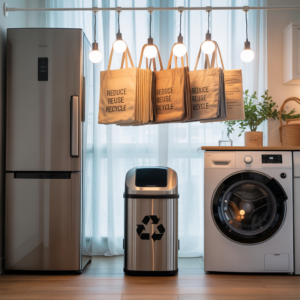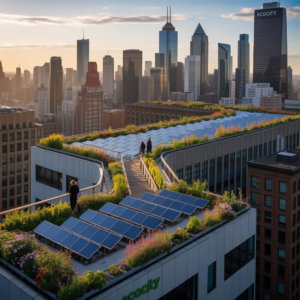17 Simple Tips for Living More Sustainably in a City Apartment in 2025
Introduction
Urban living presents unique challenges—and opportunities—for those seeking a more sustainable lifestyle. With limited space, shared amenities, and a fast-paced environment, city dwellers may feel that eco-friendly living is out of reach. However, even small changes in daily routines can make a significant impact on both the environment and your well-being. By adopting city apartment sustainability practices in your city apartment, you can reduce your carbon footprint, conserve resources, and contribute to a healthier urban ecosystem. Here are 17 simple, actionable tips to help you embrace city apartment sustainability and make your home an eco-friendly haven.
1. Choose Energy-Efficient Appliances
Opt for appliances with energy-saving certifications, such as ENERGY STAR, to minimize electricity consumption and reduce greenhouse gas emissions. Energy-efficient refrigerators, washing machines, and air conditioners use advanced technology to deliver the same performance while consuming less power, ultimately lowering your utility bills and supporting sustainable living.

2. Switch to LED Lighting
Replace traditional incandescent bulbs with LED lights, which use up to 75% less energy and last significantly longer. LEDs are an easy upgrade that can dramatically cut your apartment’s energy use while providing bright, comfortable lighting for every room.
3. Unplug Devices When Not in Use
Many electronics draw power even when turned off, a phenomenon known as “vampire energy.” Unplug chargers, small appliances, and entertainment devices when not in use to prevent unnecessary energy waste and promote eco-friendly habits.
4. Maximize Natural Light
Take advantage of natural sunlight by keeping curtains and blinds open during the day. This reduces the need for artificial lighting and can help warm your apartment in cooler months, lowering both energy use and costs.
5. Reduce Water Usage
Install low-flow showerheads and faucet aerators to conserve water. Fix leaky taps promptly and adopt habits like shorter showers and turning off the tap while brushing your teeth. These small changes add up to significant water savings over time.
6. Start Recycling and Composting
Set up a simple recycling system in your apartment for paper, plastic, glass, and metal. If possible, start a small compost bin for kitchen scraps like fruit peels and coffee grounds. Composting reduces landfill waste and creates nutrient-rich soil for plants.
7. Embrace a Zero-Waste Lifestyle
Prioritize reusing items, reducing consumption, and recycling wherever possible. Use reusable water bottles, coffee cups, and shopping bags. Buy only what you need and think twice before making new purchases to minimize waste.
8. Decorate with Sustainable Materials
Choose home decor made from eco-friendly materials such as bamboo, cork, recycled metals, or reclaimed wood. These options are not only stylish but also have a lower environmental impact than conventional materials.
9. Buy Secondhand or Vintage Furniture
Shop for furniture and decor at thrift stores, online marketplaces, or vintage shops. Buying secondhand extends the life of existing items and reduces demand for new resources, supporting a circular economy.
10. Incorporate Air-Purifying Plants
Indoor plants like snake plants, pothos, and peace lilies help filter air pollutants and improve indoor air quality. They also add a natural, calming touch to your apartment, contributing to both sustainability and wellness.
11. Use Eco-Friendly Cleaning Products
Switch to cleaning supplies made from natural, biodegradable ingredients. Avoid harsh chemicals that can pollute indoor air and water systems. Many eco-friendly brands offer effective alternatives with minimal packaging .
12. Opt for Sustainable Personal Care Products
Choose personal care items with eco-friendly packaging and natural ingredients. Look for brands committed to ethical sourcing and minimal environmental impact, and consider products like bamboo toothbrushes or refillable containers.
13. Minimize Single-Use Plastics
Reduce reliance on disposable plastics by using alternatives such as glass storage containers, beeswax wraps, and cloth napkins. These swaps are simple yet effective in cutting down plastic waste in your daily life.
14. Practice Smart Temperature Management
Maintain moderate temperature settings on your thermostat and use fans or layered clothing to stay comfortable. Avoid overusing heating and cooling systems, which are major contributors to energy consumption in city apartments.

15. Try Vertical Gardening
If space is limited, create a vertical garden using shelves, wall planters, or modular systems. Grow herbs, leafy greens, or small vegetables indoors or on your balcony. Vertical gardens purify the air, regulate humidity, and provide fresh produce right at home.
16. Support Renewable Energy Initiatives
Where possible, participate in community solar programs or use portable solar-powered devices for charging electronics and lighting. Even small investments in renewable energy can help reduce your apartment’s reliance on fossil fuels.
17. Engage in Sustainable Transportation
Choose public transport, cycling, or walking over driving whenever possible. Many city apartments are located in walkable neighborhoods with easy access to amenities, making it easier to live car-free and reduce your carbon footprint.
Conclusion
Sustainable living in a city apartment is not only achievable but also rewarding. By implementing these 17 simple tips, you can make a meaningful difference in your own life and the broader urban environment. From energy-efficient upgrades and waste reduction to mindful consumption and green decor, every small step contributes to a more sustainable, eco-friendly lifestyle. Start with a few changes, build new habits, and inspire others in your community to join you on the path toward urban sustainability. Together, we can create greener, healthier cities—one apartment at a time.





Very valuable and relevant!